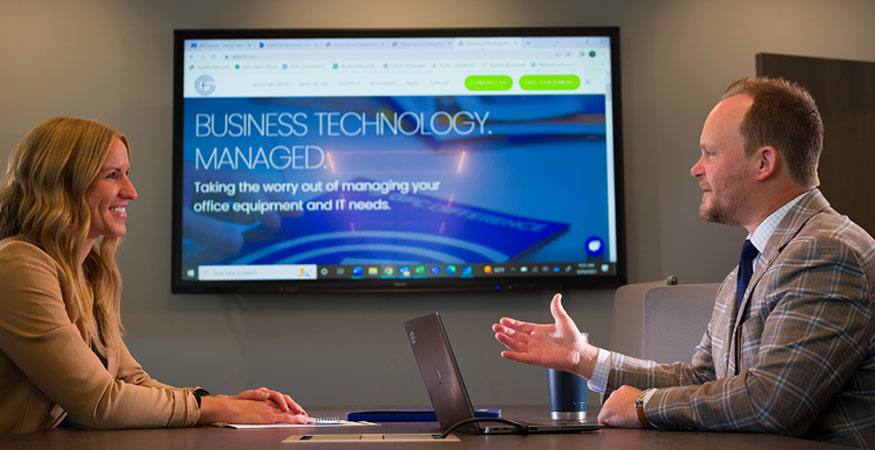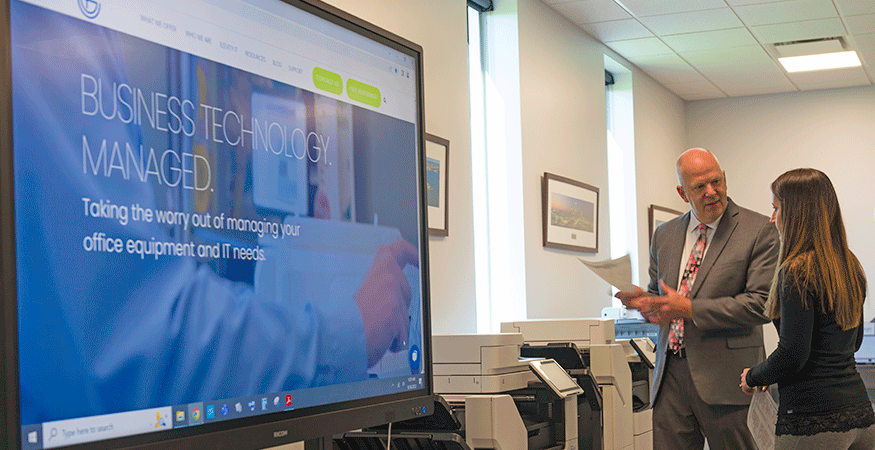Interactive displays have the power to completely transform the way communication and collaboration are conducted in modern business environments. By seamlessly integrating the simplicity of a traditional whiteboard with the advanced features of a computer, interactive displays offer a dynamic and interactive platform for teams to work together effectively. From real-time editing and annotation to the seamless integration of multimedia content, these state-of-the-art tools will enhance the quality of all of your meetings.
Businesses of all sizes have found interactive displays to be effective additions to their office equipment fleet through their Managed Print Services (MPS) provider.
How might an interactive display increase the productivity of your staff? Here’s what you’ll need to know:
- What Is an Interactive Display?
- How Interactive Displays Work
- Why Every Business Should Consider Interactive Displays for their Meeting Rooms
- Step-by-Step Guide on How to Use an Interactive Display
- The Strategic Benefits of Interactive Displays for Business Collaboration
By investing in interactive displays, businesses can create a collaborative culture that fosters creativity, problem-solving and knowledge retention, ultimately driving innovation and competitiveness in today's fast-paced business landscape.
What Is an Interactive Display?
An interactive display is a state-of-the-art digital alternative to traditional whiteboards or paper flipcharts. They are multifunctional tools that combine the simplicity of a whiteboard with the power of a computer. An interactive display, also know as an interactive flat panel display (IFPD), allows users to display images and data from a connected device, interact with the content directly on the board with a finger or stylus and capture all the written or drawn notes made during a meeting.
An interactive display typically consists of a touch-sensitive panel connected to your computer and a small camera positioned toward the room of meeting attendees. The computer can be used to access documents or presentations in your files or network. Users can then manipulate the information using the computer or directly on the panel using touch gestures or a specialized stylus. This ability to interact with digital content makes interactive displays a dynamic tool for presentations, brainstorming sessions and collaborative work.
Businesses have found interactive displays to be especially effective when conducting meetings with geographically disperse groups. This includes staff at alternate locations, remote workers, vendors and customers.
RELATED: What Is a Smart Board and Why Do Educations Love Them?
How Interactive Displays Work
Interactive displays offer a variety of functions and features designed to enhance business meetings and collaborative sessions. Their touch-sensitive surfaces enable real-time editing, note taking and navigation of displayed content.
Some models even include handwriting recognition software, allowing users to convert handwritten notes into text. Most interactive displays also support multimedia content, such as videos and audio and may also include tools for highlighting, drawing and creating standardized shapes.
Advanced models often come with multi-touch capabilities, enabling multiple users to interact with the board simultaneously. Wireless connectivity options, integration with cloud services and compatibility with a wide range of software applications further expand the functionality of interactive displays.
In summary, interactive displays are a versatile tool designed for today’s modern business environment.
Why Every Business Should Consider Interactive Displays for Their Meeting Rooms
In today's fast-paced business world, technology that connects employees, vendors and customers for enhanced collaboration – is priceless. Sure, face-to-face meetings are still important. However, the option of remote collaboration has been an eye-opening tool for increasing office productivity.
Interactive displays offer a compelling meeting solution for geographically disperse teams by transforming a simple meeting room into a dynamic workspace. They encourage participative meetings, where team members can contribute actively with immediate effect. This level of engagement can significantly enhance the quality of discussions and brainstorming sessions.
Furthermore, the visual and interactive nature of interactive displays cater to a variety of learning styles, ensuring that information is conveyed clearly to everyone.
Step-by-Step Guide on Using an Interactive Display
Working with a MPS provider is often the best bet for a business. A MPS provider has the expertise to help you select the correct model of interactive display that will best fit your needs. And an expert MPS provider will train your staff on proper usage to make sure that everyone feels comfortable accessing the technology for their meetings.
To interact with the content, you can use your finger, stylus, or any interactive tool provided to navigate through files, open applications or access the internet. Use the annotation tools to draw or write over presentations and documents and don't forget to save your session's notes for future reference. With a little practice, utilizing the board's features will become second nature, enhancing your meetings and collaborative efforts.
The Strategic Benefits of Interactive Displays for Business Collaboration
Interactive displays offer strategic benefits that extend beyond mere convenience. They foster a collaborative culture by providing a platform that encourages all participants to engage actively with meeting content.
Here’s some of the most popular benefits our customers have found when using their interactive displays:
- The presenter and all attendees can see one another and the presentation, in real time
- Speakers are empowered as they can see the see the reactions and comprehensions of remote attendees
- Audio and video allow for interactive Q & A sessions
- Word documents, PDFs, images, videos, PowerPoint presentations, etc. can be displayed and viewed by all meeting participants both in the meeting room and remotely via the internet and meeting application software
- Presenters can easily zoom in and out of presentations or documents for visual emphasis
- Touch screens allow presenters to mark up documents in real time
- All meeting documents can be securely saved on your company’s network
Additionally, the use of interactive displays can lead to more streamlined and paperless meetings. Not only is this a more environmentally friendly option – it can also promote cost savings. Overall, interactive displays are a smart investment for businesses looking to stay competitive and innovative in their communication and collaboration practices.
The Gordon Flesch Company (GFC) Blog is your go-to resource for the latest news and ideas about managed print solutions, managed voice services and financing business equipment. Subscribe to the GFC Blog, today!










